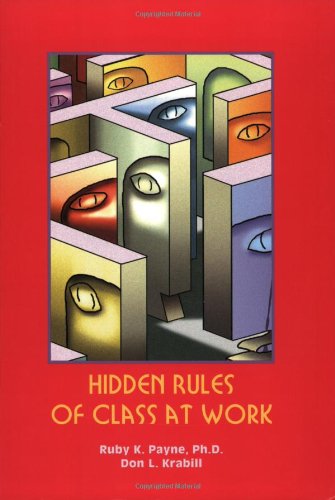Kundendienst
Kundensupport
Regionaler Zugang
Rechtliche Hinweise und Richtlinien
Holen Sie sich die App

Richten Sie Ihre Kamera auf den Download der App
Copyright © 2024 Desertcart Holdings Limited



Full description not available
M**R
Valuable Professional Resource
I pursued this book for my own personal and professional development, in a sincere effort to better understand and work closely and effectively with people from all social strata. Ruby Payne’s work was recommended to me by my accomplished career educator mother, and the book, indeed, provided significant insight. My foremost critique of the book is it’s over-simplified, homogenous characterization of the ‘wealth’ class, largely segregating this group into only ‘old’ and ‘new’ wealth populations, a flat reduction of a more dynamic, nuanced, and varied population, at best. Regardless, the point of the work focuses dominantly on ‘poverty’ and ‘middle class’ groups. Broad impressions made ring generally true and have become helpful to me in my daily work with members of all generational income and cultural communities. I highly recommend this book as a professional resource to anyone seeking deeper cultural understanding to most sensitively and successfully liaise with members of all ‘classes’ to engage in mutually equal, effective work and work environments.
J**W
Hidden Rules of Class at Work
Payne points out some of the unspoken rules of class in the world of work. While much of what she says in this work is also found in her earlier work, her application of this material to the work place is very helpful. While she doesn't explicitly say it, she implies that people of the middle class, who attempt to minister to people of the lower socioeconomic level, find themselves also dealing with members of the upper class who have their own hidden rules of class, and it is helpful to be aware of these rules.
A**R
Great book, learned new knowledge about class
I like about the principals and the scale in each books. However, the ending conclusion seems to be assertion with no evidence to back it up(emotion score correlate to resource score....etc). The .0002 and .0000 has no unit, and the way the author describes it looks like a correlation coefficient.... In which that means the two measuring item has no correlation. Although author attempt to add research to make it look more credible, the conclusion is just very confusing.
R**.
A must-have for anyone trying to understand socio-economic class in the U.S.
Like "Framework for Understanding Poverty" this book was a paradigm-shifter for me. All the cliches apply: it opened my eyes, i see things more clearly, etc. It helps you understand the dynamics at play between working class, blue collar and white collar environments. This is a great book and the ideas are so intuitive and "click" so clearly, that you will be thinking about it for years to come. Cannot say enough good things about it.
A**N
Interesting views...
The author has some interesting views on the topic. I don't agree with all of them (I doubt many readers will) but she does a great job illustrating her points. Eye opening and quite interesting!
I**V
Excellent "That's Absolutely Right Book".
This is one of those books that you read and you think to yourself, that's right, how come I hadn't thought of that. It sort of helps open one's eyes to the truth of class and elitism in groups and people who in our everyday lives project themselves as common folk, as part of the people, yet symbolism, ritual, attitudes, conscious and not say otherwise. I would recommend this book to anyone who has a supervisor, a boss, and anyone who is a supervisor and/or a boss.
S**D
hmmmm
I don't buy into her philosophies or characterizations of the socio-economic classes -- trying to fit folks into one box never works in specificity, and only a wee bit generally. That being said, you'll find some interesting tidbits to gnaw on -- and a somewhat helpful frame to use if you are trying to open some doors to exploring tensions in the workplace.
L**R
More people should read
This should be a class in high school and college. Everyone needs to understand theses social behaviors as well as their own filters and perceptions.
TrustPilot
vor 4 Tagen
vor 3 Wochen